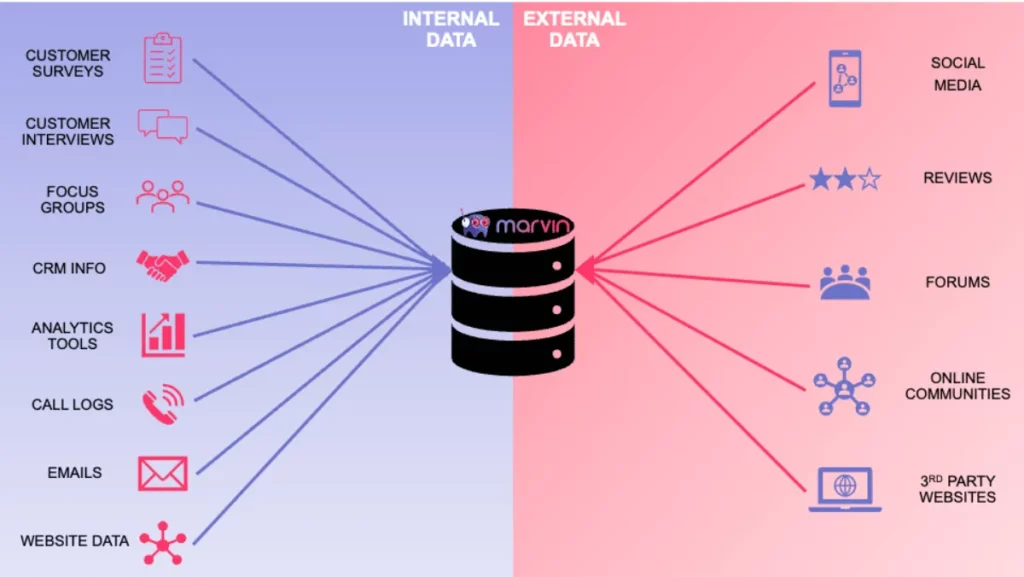Apple is one of those companies that excel at creating products people love. Their secret? Deeply understanding user needs.
The company uses personas to represent its customers’ needs, goals, and workflows. These personas guide the design. But most importantly, they act as a roadmap to creating products that balance functionality, simplicity, and innovation.
If you’d like to do the same, this article will:
- Show you how to develop an accurate AI persona that guides irresistible product designs
- Introduce you to Marvin, our AI-powered assistant, that can automate all your user research analysis
Marvin is a great starting point for analyzing user data and extracting insights about buyer personas.
Create your free account today to use this personal AI assistant for all your research needs. You can uncover your first insights within one hour of adding research to your account.

What Makes a User Persona?
User personas are archetypal users who represent a large group of people with similar:
- Demographics: Age, occupation, gender, education & income
- Psychographics: Lifestyle, goals, needs, motivations, attitudes, frustrations
- Behavior: The way users interact with a product
A company’s ultimate goal is to create value for its customers. Harvard’s value stick illustrates that customer delight is an integral part of creating value and capturing profit.
So, how do firms increase customer delight?
They build personas to understand more about their users.
Well-rounded user personas incorporate both quantitative and qualitative data. Quantitative data from analytics and surveys helps researchers find trends in data. Qualitative data brings contextual richness — it gives researchers a better understanding of users and their needs.

Why User Personas Matter
To create products that delight users, you need to understand them first.
Personas aid designers in numerous ways:
- Personifying potential users helps establish user empathy. User personas enable designers to identify who they are designing for. Designers can put themselves in the customer’s shoes. Understanding user needs and expectations, they identify with whomever they’re designing for. All stakeholders develop a better understanding of end users. It helps everyone keep these users in mind when creating a product.
- Personas aid in defining product strategy. Designers can decide which features are and aren’t necessary. They can prioritize features based on how they cater to the main persona. With detailed user information, personas help remove guesswork from decision making.
- Creating products for personas helps designers circumvent common design pitfalls. With specific users in mind, they avoid designing for elastic users. These are loosely defined users with a generic user profile, and mean different things to different stakeholders. Designers can also avoid falling prey to self referential design. This happens when they design a product for themselves, rather than the target users.
User personas help answer important questions about users. What are their interests? What communication channels do they use? What features do they need?
Not knowing what appeals to customers is the equivalent of shooting in the dark.

Industries That Benefit the Most from AI Personas
Audience understanding is crucial for success in any industry.
All businesses aim for more effective targeting and personalized experiences, but AI-driven personas have the most significant impact in these industries:
| Industry | What AI analyzes | AI personas examples |
| E-commerce | Browsing history Purchase patterns Social media activities | Value seekers Luxury buyers Impulse shoppers |
| Online gaming | Gameplay data In-game behavior Social media activities | Socializers Explorers Competitive players |
| Streaming services | Viewing/listening habits Ratings Search queries | Binge-watchers Genre enthusiasts Casual listeners/ watchers |
| Online education | Learning patterns Course completion rates Interaction with learning materials | Visual learners Auditory learners Self-directed learners |
| Social media platforms | User posts Interactions Network connections | Influencers Community builders Lurkers |
How Machine Learning Helps with Persona Creation
Marketers and designers used to create personas manually. They’d collect demographic information and conduct interviews to craft user personas. Traditional persona creation had a few blatant downsides:
- The process was tedious and resource-intensive. We’re talking about the big 3 – time, money and people.
- Research methods relied on in-person data collection. Therefore, online behavior wasn’t accounted for. This created a disconnect between the data collected and actual user behavior (most of which was happening online).
- People’s tastes change all the time. Crafting and refining user personas is an ongoing activity. Constantly updating user personas is expensive.
- Researchers relied on guesswork to fill any knowledge gaps. Decisions made based on incorrect assumptions can harm a product in the long run.
Machine Learning (ML) addresses these shortcomings. It revolutionizes user persona creation.
Andrew Hogan, Figma’s Head of Design thinks the AI & Design fields must work in unison:
“If AI is actually going to achieve the things that people seem to think it will, it’s got to be designed well, so that people can use it effectively. Design and research have to play an integral role. It can’t just be about integrating some APIs,” he said.
Learn more about Andrew’s thoughts on the influence of Design on AI.
ML is a branch of AI that creates algorithms and statistical models. Computers continuously learn from data. They make predictions or decisions without being explicitly programmed.
When it comes to crafting user personas, ML can perform heavy lifting. It can analyze large datasets from various sources:

These detail user behavior, preferences, demographics and other relevant information. And help build dynamic user personas. That’s fancy speak for personas that change and evolve with user tastes and preferences.
To analyze all this data, you need a centralized research repository. Learn why Marvin is the one-stop shop for all your research data.
Keep your user personas up-to-date, digital and flexible with ML. It enables designers and developers to build user-centric products. Refining personas is a continuous process that evolves with the product. Every piece of information used to define your customers brings you a little closer to them.
Steps to Create User Personas
Without further ado, let’s explore how to set up a successful user persona:
1. Gather Data
Conduct user research to better understand their mindset, motivations and behaviors. Interview and observe a sufficient number of people who represent the target audience.
All companies are different. Extensive field research may not be possible due to resource restrictions (the big 3). All hope isn’t lost. Create provisional personas from customer support logs, web analytics and competitive intelligence. This acts as a placeholder until you populate a persona with real user data.
Failing to build personas from user research is a big no-no. Avoid creating stereotypical users from people’s understanding or imaginations.
Learn how market research tools help gather data to drive business growth.
2. Analyze Patterns in Research Data
During this stage, look out for patterns in the data that makes it possible to group similar people together into user groups. Here’s how:
- Observe how user behavior differs across participants. List the behavioral variables.
- Map these variables to real life attributes.
- Find sets of people with similar attributes. Grouping these people together forms the foundation of each distinct persona.
3. Use ML to Create User Groups
ML Algorithms can conduct a high level clustering of audiences. Segmentation takes place based on demographics, purchase patterns and behavior.
Clustering begins with mining large datasets. Algorithms find similarities between variables and groups similar data into sets. Once AI identifies persona segments, ML can auto-fit customer datasets against them. As new data becomes available, machines constantly learn and tweak group information.
This enables businesses to keep up with changing user tastes and preferences. It allows them to demarcate between persona segments and target them contextually using the right channel.
Learn more about ML-enabled clustering in the persona tools section below.
4. Introduce Personas to Scenarios
The buck doesn’t stop at developing personas. You’ve got to deploy them. Let us explain.
By themselves, user personas are just detailed user profiles. As designers and developers, we’re interested to see users operate in various scenarios of interaction.
Scenarios are hypothetical situations that describe how users would interact with a product. With their end goals in mind, this helps designers understand a user’s requirements. From these, they design solutions to help users achieve these goals.
Learn how to incorporate AI in UX research.
Don’t forget to share your findings across the organization. It’ll raise awareness of the user journey and keep users at the forefront of everyone’s minds.
Our CEO shares his tips for creating a culture of customer obsession.
5. Helpful Information for Persona Creation
Keep these useful pointers in mind during the persona creation process:
QUESTION: How many user personas do I need to create?
There isn’t a hard-and-fast rule here. In a perfect world, you’d be covering 100% of your customers. That’s not realistic.
A product may have four or five persona segments attached. Yet, each segment doesn’t hold equal weight. One or two will be the primary personas, the users you’ll prioritize during design. The remainder are secondary personas, whom you should accommodate.
Traditionally, designers created less than 10 personas. So as to not overwhelm decision makers with information. AI adds search, filter, generate and recommend functionalities to the persona creation process. This raises the number of personas possible.
Focus on rocking a decent coverage(%) of your customer base. Taking into account your own resource constraints.
PRO TIP(S): Give your personas a name. It makes them instantly recognizable. Make attributes the same across the board to easily differentiate between personas.
WARNING: Don’t use any real names or user details in personas. This adds bias and compromises objectivity. You’ll tend to focus on the person, rather than the needs of the user group they represent.
REMINDER: Like plants in a garden, these personas need constant care. Leverage AI and ML technology to constantly update and refine user personas.

Benefits of Using ML to Create User Personas
So what are the pros and cons of using machine learning in persona creation? Here are some of the benefits of creating AI personas:
Speed & Efficiency
AI helps streamline the persona creation process. It generates customer insights rapidly. Traditional research methodology is time-intensive and expensive. Researchers manually carry out participant recruitment, interviews and analysis. AI automates these cumbersome tasks, freeing up a researcher’s time. It has the ability to process millions of data points swiftly. Systems scour behavioral and transactional data to help create and refine user personas.
Scalability
AI processes large amounts of data, so companies can scale up their operations quickly. UX professionals suddenly have more time on their hands. Attack AI with unlimited questioning. Gather extensive feedback without time constraints. This allows for a more comprehensive understanding of user behaviors. AI makes it possible to maintain personas for extensive datasets or diverse audiences.
Data-Driven Decision Making
Persona creation tools integrate with data analytical tools such as Google analytics. User personas update in real-time with the latest available data. This ensures a dynamic and up-to-date representation of user trends and preferences. AI persona generation enables agile iterations. It allows refinement of strategies in real-time. These are crucial in a fast-paced business environment.
Personalization
Last, but certainly not least. AI is highly effective in aligning web content with search intent. This means that AI learns what consumers like. What content do they want to see? What channels are most effective for reaching them? Crafting more personalized marketing messages helps attract users to a product. AI can help designers create user experiences that feel tailormade to various personas.
Companies that integrate AI into persona creation have a significant competitive advantage. Future-proofing their technology stack allows them to meet the evolving needs of customers.

Limitations of Using ML to Create User Personas
Reader beware. Look out for these downsides of using ML in the persona creation process:
Lack of Human Involvement
AI doesn’t have human intuition or judgment. It struggles to grasp emotional nuances of user behavior. With little to no understanding of the context, it’s liable to misinterpret situations. Failure to grasp the full context of user behavior leads to inaccuracies in insights.
Over Reliance on Quantitative Data
Machines learn more about users from their clicks, scrolls and general online behavior. This data is largely quantitative. That’s only one side of the coin. ML is yet to break into analyzing qualitative data as effectively. You still need a human being to unpack and decipher meaning from qual data. This Deloitte study clearly illustrates why.
Data Quality
Data output is only as good as the input. The quality and reliability of input data directly affects the quality of results. Training data is more than likely biased. This can impact the accuracy of generated user personas. Biased input data may perpetuate and amplify these biases.
With these limitations in mind, it’s essential to combine AI’s capabilities with human judgment. Remember:

User Persona Creation Tools
Check out these nine tools to help you create solid user personas with AI:
1. Marvin
Feeling overwhelmed with all the information you collected? Want to make sure you’re not missing the most important insights?
As a research repository and AI research assistant, Marvin can easily organize and centralize all your qualitative and quantitative data. Our AI-powered platform will:
- Automatically extract high-quality, well-organized inputs you can use to create accurate personas
- Provide you with collaborative features to quickly share and refine insights across teams
- Integrate with tools such as FigJam and Miro, where you can visualize personas or refine them with affinity mapping
Create your free Marvin account today and see how this tool bridges the gap between research and well-documented user personas — all while fitting into your existing workflows!
2. QoQo
Designers will love this Figma plugin that creates cards based on users’ goals, needs, motivations, frustrations, and tasks.
It’s a great little helper for teams with limited budgets or no internal UX experts because it lets you:
- Create user journey maps to connect insights
- Speed up discovery with data-driven briefs and questionnaires
- Quickly generate personas and identify key challenges or risks to refine your design strategy
3. Xtensio
This tool facilitates real-time collaboration and includes highly customizable AI-driven persona templates.
As a business communications platform, Xtensio helps you nail the tone and messaging for each persona. Use it to:
- Create visually engaging personas with drag-and-drop features, charts, and images
- Customize templates to align with your brand’s colors and style guide
- Reuse and repurpose templates across research and strategy documents
4. Make My Persona
HubSpot created this free web tool that seamlessly integrates with its CRM application. It guides you through the process step by step. And you can add details to each profile to craft well-rounded and exportable user personas.
Small to medium businesses that need a simple yet effective persona-building process will appreciate the ability to:
- Break down personas into actionable segments for marketing, sales, and UX design
- Incorporate suggested questions to gather comprehensive user insights
- Access downloadable, export-ready profiles to streamline cross-team communication

5. UserForge
Let UserForge help you create personas for specific scenarios. Besides user persona templates, they offer scenario-backed modeling with dynamic persona creation. This makes it easier to tailor UX design to varying needs.
Experimenting with this tool allows you to:
- Provide a few lines about your audience and let AI brainstorm archetypes
- Add images, icons, and clear visuals to create engaging visual personas
- Sync user stories directly into Jira to connect personas to actionable workflows
6. Persona.ly
Here’s an ML-driven tool for creating personas. Persona.ly conducts behavioral analytics and generates insights that can be viewed on a customizable dashboard.
This persona AI generator is worth a try because it lets you:
- Match personas with behavioral patterns based on aggregated user data
- Visualize insights for specific audience segments to refine targeting strategies
- Launch campaigns or gather research data from diverse markets quickly
- Use ML to optimize survey targeting and improve response quality
7. Up Close & Persona
Using AI to analyze interviews and generate persona reports, Up Close & Persona provides a nuanced understanding of target audiences. The name may be a bad pun, but this tool is on the money. Expert B2B marketing strategist Ardath Albee designed it.
If you want to refine your buyer insights, use it to:
- Capture the broader factors influencing buyer decisions within the buying cycle
- Tailor personas for multiple customer types, ensuring better-targeting strategies
- Transform interview data into actionable insights for B2B marketing success
8. Datagran
Datagran is a no-code tool that helps you build AI and ML workflows. This ordinarily complex and time-consuming process becomes more accessible by setting a clustering algorithm.
Take a look at some of Datagran’s most representative features below:
- Extract, load, and connect data from multiple sources for persona analysis
- Interact with AI bots to ask questions about your data in plain language
- Build and share customizable charts and dashboards, including embedded reports in Notion
- Get data insights and alerts via Slack, WhatsApp, or Teams for real-time updates
9. Delve AI
This AI-enabled tool helps you create personas from social media, Google Analytics, and your CRM. It performs a competitive analysis and uses its AI intelligence data to construct personas of your competitors.
Delve AI is a robust platform for persona creation and actionable marketing insights that lets you:
- Build buyer, competitor, employee, and website personas automatically using integrated data sources
- Segment shoppers or track organizations to tailor strategies for specific industries
- Transform persona insights into actionable marketing ideas for SEO, social media, and PR
- Sync with HubSpot, Salesforce, Shopify, and more to streamline persona development
Did you enjoy discovering these tools and want to explore the topic further?
Learn about the various kinds of persona creation tools, and their pros and cons here.
Here’s our list of the best AI tools for UX research and design.

Tips to Use a UX Persona Generator Effectively
To get the most out of a UX persona generator, follow these guidelines:
- Align the generator with your project goals: Before diving in, define your goals. What kind of personas do you need, and how will they inform your design?
- Curate reliable input data: Persona generators rely on data, so you must give it accurate, relevant data. Use recent metrics and avoid feeding the tool with incomplete or noisy information.
- Adapt personas for real use cases: Your generated UX personas should act as a foundation, not a final product. Add real-world details, behaviors, or preferences based on your team’s insights.
- Focus on primary personas: Don’t create too many personas at once. Start with one or two primary user types and expand only if necessary.
- Validate personas with real users: Not even the best generator is perfect. Test your personas by comparing them to feedback from actual users.
- Use personas beyond the design team: Make sure your user personas are relevant to stakeholders in marketing, customer support, and development. Aligning all teams creates a user-focused culture.
- Revisit and adjust regularly: Update personas as user behaviors and business goals evolve. A static persona will eventually become irrelevant, as opposed to a dynamic one.

Key Considerations for Persona Technologies
Persona tech can be a powerful asset or a major headache. With the wrong tools, you’ll get a distorted view of your audience. Even worse, you risk building your entire strategy on flimsy, inaccurate personas.
Here’s what to consider to make the right choice:
Data Integration Capabilities
Your persona tool should pull data from multiple sources — web analytics, CRMs, and social media. Seamless integration is mandatory if you want comprehensive, dynamic personas.
Scalability
As your business grows, so will your data. Pick a tool that scales effortlessly to handle increasing volumes of user information.
Real-Time Updates
User behaviors change fast. The tech that offers real-time updates keeps your personas accurate and aligned with current trends.
Customization Options
One size doesn’t fit all. To find the right size for your needs, look for tools that let you customize personas based on your specific audience and goals.
User-Friendly Interface
Not everyone on your team is a data expert or a tech geek. Choose technology with a simple, intuitive interface that’s easy for anyone to use.
Bias Detection and Mitigation
Tools that include bias detection can help avoid skewed personas. This is critical for ethical and accurate user understanding.
Cost vs. Value
Evaluate pricing against the features you’re getting. Some tools offer free versions with basic functionalities, while others provide robust enterprise solutions.
Compliance and Security
Last but not least, your software must adhere to data protection laws like GDPR or SOC2. Check if it handles sensitive user information responsibly.

Future of AI-Generated Personas
AI-generated personas are changing how businesses understand and connect with users. As artificial intelligence evolves, so will the depth and accuracy of personas.
Let’s look at four exciting trends shaping the future of this technology:
1. Predictive Personalization
Traditional personas offer a snapshot of a user at a specific point in time. In contrast, AI-powered personas are gearing up to predict what users want before they know it themselves.
How is that possible?
Through proactive personalization, which stems from analyzing historical data, real-time behavior, and contextual clues.
Streaming services already recommend movies based on past viewing history. Predictive personalization could make suggestions depending on the time of day, social media sentiment, or even the weather!
2. Real-Time Adaptation
User behavior is dynamic, and static personas struggle to keep up. That’s why AI personas will evolve on the fly, constantly updating based on user actions and interactions.
This trend can be especially powerful in e-commerce. Websites could dynamically adjust product recommendations based on a user’s:
- Current browsing session
- Recent purchases
- Previous interactions with customer support
Did a customer recently ask support about returns? If so, the next time they visit the website, they’ll see products with easy return policies prominently displayed.
3. Multimodal Data Fusion
The days of personas based on basic demographics are over. Future personas will draw from myriad data, including text, images, audio, biometric info, and more.
Think about a fitness app. It could track steps and consider users’ sleep patterns, diet, or the playlists they listen to during workouts.
The result? A 360-degree understanding of a customer’s health journey customized to them.
4. Ethical AI Frameworks
As AI personas become smarter, they must also become fairer.
Transparency and ethics will take center stage, with tools built to detect biases and ensure equal representation.
For example, algorithms will highlight whether certain groups are underrepresented or assumptions reinforce harmful stereotypes.
Businesses that prioritize ethical and responsible AI in persona creation and design will earn trust. Also, they’ll future-proof their strategies against reputational risks.

AI-Generated Personas
In the era of AI, a new type of user persona is emerging.
AI-generated personas are digital characters built from swathes of public and private data. Created entirely by AI, it imitates the behavior and qualities of a real human.
Also known as synthetic users, AI-generated personas act as ‘digital stand-ins’ for real users. They present an alternative option for companies to create user personas. The end goal is the same – to understand more about a company’s customers.
Generating AI personas is cost-effective, as compared to traditional market research. There’s no restriction on how many users you can generate, so it’s completely scalable. AI algorithms produce more accurate results than traditional methods in far less time.
Use Cases for AI-Generated Personas
When it comes to creating user personas, nothing replaces real user data. However, there are some use cases for businesses to create and use AI-generated personas:
- During initial research. Use personas to segment customers and understand different user journeys.
- Startups or small businesses. These companies don’t have the resources to conduct their own research. Generating personas is helpful during initial stages of product development.
- Fast-paced businesses. These companies need to adapt quickly to changes in user needs and preferences.
- Marketing campaigns. Businesses use AI-generated personas to fill in any information gaps. They do this to better understand the spectrum of users.
- Conversational interfaces. AI-personas are now commonplace in chatbots, search and more. They provide an opportunity to create interactions and gather valuable user data.

Challenges with AI-generated Personas
Proceed with caution before using AI-generated personas. Watch out for these inherent challenges:
- Recognizing Context. AI personas need to have an understanding of the context to generate meaningful responses. Currently, they don’t possess the contextual processing ability of humans.
- Complex Interactions. AI still struggles to comprehend complex interactions and human emotions. This information is important for researchers to grasp how people react to a product.
- Algorithmic Bias. While AI reduces human bias, it’s likely trained on a biased dataset. This can trickle its way down into research findings and skew results.
- Data Ethics. Companies must not misuse people’s personally identifiable information (PII). Follow data compliance laws and regulations to protect user data. Marvin is SOC2 and GDPR compliant, so your user data is always protected.
AI-generated personas are a starting point. A high quality “first draft” of user personas. It’s vital to add your own research (using rich data) to user behavior analysis.
Outstanding Experiences Originate from Personas
Everyone wants personalized content. That’s why we love our Netflix and YouTube home pages. They reflect our tastes and show us stuff we’d like to watch. Experiences that seem tailor made for us.
Personas are a powerful tool that help make that happen. Using AI in the persona creation process simplifies data collection and segmentation.
Personas guide product ideation. Understanding user personas deeply helps designers create products that solve actual customer problems.
User personas ensure that designers keep the user at the heart of every decision.

Frequently Asked Questions (FAQs)
Before we wrap it up, here are some quick FAQs on the topic of dynamic AI-generated personas:
How Do AI Personas Improve User Research?
Manually created personas may rely on subjective input. AI personas, however, result from analyzing large datasets and uncovering patterns and trends that may otherwise be overlooked.
Because they’re more accurate and representative of real users, AI personas help you maximize user research. They inform designs that better meet users’ needs.
What is the Best Marketing Persona Generator?
The best persona maker depends on your needs. For simplicity, a tool like HubSpot’s Make My Persona works well.
For more advanced AI-driven options, Delve AI or Persona.ly offer robust features.
Look for tools that integrate with your existing platforms and provide real-time updates.
Can AI-generated Personas Replace Traditional Methods?
AI-generated personas streamline the process and can reduce the need for manual persona creation.
However, they won’t fully replace traditional methods. Human oversight remains critical to ensure accuracy, context, and emotional depth.
How Accurate Are AI Personas Compared to Human-created Ones?
While their accuracy depends on the quality of human-gathered data, AI personas tend to:
- Involve less bias
- Reflect data patterns more accurately
- Translate the user research more effectively
Manually created personas can offer more emotional nuance. But AI personas excel in consistency and the speed with which they’re generated.

Conclusion
AI makes persona creation simpler, faster, and more accurate.
However, human oversight is vital for adding the emotional context, nuance, and ethical judgment that AI may lack.
Together, AI and researchers create data-driven, deeply relevant AI personas.
If you wish to use some AI super-powers, let Marvin be your partner and help you:
- Streamline large customer data sets
- Automate customer insights analysis
- Guide persona creation with insight and empathy
Create a free Marvin account today to craft better personas with the best of AI and human expertise.




